In the year 1992, Hollywood was intruded on by a young, voracious cinephile whose arrival would herald a new style of filmmaking. Crime, gore, violence, pop culture references, expletive, and non-conventional screenplays became the trademark of his cinematic style. Each of the films directed by the maverick has compelling visual aesthetics. His films have explored themes and emotions through their characters conveying hidden and subtle messages within the plot. In Quentin Tarantino’s oeuvre of filmmaking, Inglourious Basterds (2009) stands out as an exemplary endeavor.
No other film, written by Tarantino has ever incorporated an alternate history within the structure of the screenplay. Two primary events in the film — the killing of Adolf Hitler and American soldiers winning over the Third Reich are creative reconstructions. The film’s synopsis can be briefly summed up as: World War II hasn’t ended and Germany is in their first year of occupation of France. Lieutenant Aldo Raine, played by Brad Pitt, assembles a team of Jewish-American soldiers in his commando team of ‘Basterds’ to combat the atrocities of the Nazis.
WATCH: How To Write Great Dialogue
Their modus operandi is not only killing the Nazis but also taking off their scalps. German Actress Bridget von Hammersmark, played by Diane Kruger, is working as an undercover allied agent for the British. Along with the Basterds, she’s also the part of a mission to execute Hitler. Their destiny intertwines with a theatre owner in France, Shosanna Dreyfus, played by Mélanie Laurent, who has been harboring her vengeance towards the Nazis for brutally executing her family members.
Tarantino had divided the narrative structure of his revenge drama into five chapters, as a stylistic device to enhance his métier as a niche storyteller. So, let’s dive into each of these chapters and analyze what makes the screenplay such a unique document in screenwriting.
Chapter One: Once Upon A Time in the Nazi-Occupied France
Inglourious Basterds begins with the introduction of SS Colonel Hans Landa, the antagonist of the film. Abiding by the principle of screenwriting, Tarantino does not lose a second to hook the audience to the scene, which has a running length of more than ten minutes. As Landa interrogates M. LaPadite, a dairy farmer, sheltering the Jews underneath the floorboards, we are introduced to the cruel world of the Nazi administration. As the questioning continues, Landa tells the helpless farmer to switch their language from French to English. He does that with a purpose. The Jews won’t be able to comprehend the language.
Later in the scene, the entire Jew family is riddled with but the sixteen-year-old Shosanna miraculously escapes being struck by the Nazis’ bullets. She makes a mad dash for life. Landa takes straight-arm aims at the fleeing Jew but at the last moment changes his mind. Watch the scene here.
Takeaway from this chapter:
- The antagonist/villain in most of the film has traits that make them completely despicable. But Tarantino has endowed Landa with a charming and gentle feature. He is someone who has hidden his monstrous and manipulative traits beneath his calm interior. In fact, he is the most polite person amongst all the characters. At the end of the opening scene, he gives the audience a jolt of surprise with his deviant behavior
- We are made to believe that Shosanna, the sole survivor of a cold-blooded murdered family, will grow up and have her vengeance, sooner or later.
- We get an idea of the setting of the film, which compels us to travel with the character and engage ourselves with the wicked universe of the film.
Chapter Two: “Inglourious Basterds“
In this chapter, we are introduced to the protagonist of the film US Army Lt. Aldo Raine. He is given a task by the US Army to assemble a crack team of Jewish-American soldiers, known as the “Basterds”. Their mission is to hunt the Nazis, kill the Nazis, scalp the Nazis and carve a swastika into the foreheads of the survivors. Their brutal method works. The fear of the Basterds spread among the German soldiers. Even Adolf Hitler is rattled.
Takeaway from this chapter:
- The commanding Lieutenant, Aldo Raine, is not a lovable character even if he is on a mission to kill the Jews. When “The Bear Jew” aka Sgt. Donny Donowitz beat German Sergeant Werner Rachtman to death with his baseball bat, Aldo is eating a sandwich. He has become immune to violence. Secondly, when he carves a swastika-shaped scar on one of a German soldier’s Butz, he tells Aldo that he has become pretty good at that by just practicing. His violent acts can be justified because to combat with the Nazis one has to turn into a beast. So the audience can now expect a grand finale where both the opponents are equally powerful and ruthless.
- He informs the newly recruited eight Jewish-American soldiers that they’ll be dropped into France. Dressed as civilians they will be doing one thing and one thing only: killing Nazis. So the protagonist/hero enters this new situation willingly with a feeling of excitement and anticipation. This initiates the beginning of the conflict that starts to build between the Basterds and Germans, which helps in escalating the plot of the film forward.
Chapter Three: German Night in Paris
Here we are introduced to a grown-up Shosanna Dreyfus. She changes her identity to Emmanuelle Mimieux and runs a movie theater in occupied Paris. A famous German sniper Frederick Zoller romantically pursues her. Later Zoller convinces another German officer Joseph Goebbels to hold the premiere of ‘Nation’s Pride’ at Shosanna‘s theater and all the higher officials of the German army will attend the premiere. Shosanna hatches a plan to burn the theater down with the German trapped inside. Watch the scene here.
Takeaways:
- This chapter is very important within the overall structure of the film due to its set-up and pay-off techniques. Tarantino plants the character of Frederick Zoller while Shosanna is up on a ladder changing the marquee. Zoller is smitten by the beauty of the young Jew and makes advances towards her only to be rebuffed. But later, Zoller brings Shosanna with him for lunch and pitches Goebbels on the idea of moving the premiere of ‘Nation’s Pride’ to Shosanna‘s theater. Goebbels agrees. This becomes a turning point in the film because now individuals against whom she can have her vengeance will attend the screening. So, the entire chain of occurrences wouldn’t have been possible if Zoller was missing from the chapter.
- The arrival of Landa at the table escalates the tension. He’s assigned to provide security for the ‘Nation’s Pride’ premiere. So he takes the opportunity to have a conversation that appears more like a tender interrogation of Shosanna and her background. The function of the scene signals the imminent perilous state in which Shosanna will find herself later in the film. Tarantino introduces red herrings into his scenes, where the situation we assume will be relevant, but turns out not to be.
- As the chapter ends Shosanna tells her assistant Marcel that she will burn the Nazi High Command on the premiere night. Whether she’ll be able to execute her plan or not raises our anticipation. We’re eager to witness what lies ahead. Shosanna has now undertaken a risk and at this stage of the screenplay, there is no point of return.
Chapter Four: Operation Kino
In this chapter, we are introduced to another important character Bridget von Hammersmark, an adept double agent, working for the US and British secret service. She is supposed to meet with Lt. Archie Hicox and two German-born members of the Basterds, Wilhelm Wicki and Hugo Stiglitz in a tavern located in a small village NE of Paris, called Nadine. The purpose of this meeting is to discuss Operation Kino, a plot developed by the Allies to assassinate most of the German High Command, during the premiere of ‘Nation’s Pride’ in Paris. But the tavern is already occupied by a group of German soldiers, celebrating the birth of one of the soldiers’ sons.
Unfortunately, Hicox blows their cover and a Mexican standoff ensues between the Basterds and the Germans. Everyone gets killed in the bloodbath. But Bridget gets wounded in the leg and rescued by Aldo and his men. An alternate plan is hatched. Watch the scene here.
Takeaway from this chapter:
- As the untoward shootout happens it becomes a major setback in the narrative as the major participants of Operation Kino are killed. The conflict is overwhelming and everything works against our protagonist.
- But the disastrous events leave our protagonist with only one option: they must make one, last, all-or-nothing, do-or-die effort. Hence Bridget comes up with an idea. Aldo, Donny and Omar will attend the screening as an Italian film crew. Attending the screening becomes important because the Führer will be present there.
- The chapter ends with Landa arriving in the tavern and discovering a memento left by Bridget. The suspense builds up as the audience waits for the finale.
Chapter Five: Revenge of the Giant Face
Shosanna dressed in red waits for the screening to happen. Officials from all the ranks of the German soldiers in Paris have gathered at the theatre. Bridget has also attended the screening with Aldo, Donny and Omar, strapped with dynamite bombs on their ankles. But Landa unearths their true identity. He strangles Bridget to death and gets Aldo and another Basterd Utivich kidnapped. Landa strikes a deal with them and with their help contacts the US military service to negotiates his surrender. In the meantime, the Nazi officers have taken their seats and Marcel barricades the doors of the theatre.
In the projection booth, Zoller forces himself upon Shosanna and gets shot. But he too shoots her and both of them die together. Marcel lights the nitrate film and the theater erupts in flames. The Basterds open fire on Hitler and the other German officers. An explosion occurs from the dynamite bombs and the theatre is reduced to debris. Watch the scene here.
Takeaway from this chapter:
- The scene in the lobby, where Landa speaks with Bridget and her escorts suspecting them through their disguises brings a kind of comic relief to the narrative before the mayhem. It also plays like a shimmering suspenseful moment that reaches a boiling end with the killing of Bridget.
- Both the lead female actress, Bridget and Shosanna, are killed in the end. It is a subversion applied by Tarantino within the structure. The death of both the women depicts the bitter truth of how everyone has to pay the price when they become part of a war. So, the twist, in the end, does not at all appear to be a gimmick to shock the audiences.
- When Landa allows the mayhem to happen at the theatre and surrenders himself to the security service of the US, it adds another dimension to his character. The viewers are equally surprised like Aldo.
- In the climax, all the Germans including Hitler are killed. But what about Landa? Tarantino brings another twist in the end. He leaves the antagonist alive but allows Aldo to carve a swastika into his forehead. Landa‘s dream of a new identity is completely shattered. He now has to carry the burden of a Nazi swastika throughout his entire life. Thus the legacy of the Basterds and their inglorious acts will haunt him forever. And as Aldo utters the last line of dialogue, ‘You know somethin’, Utivich? I think this just might be my masterpiece’, it is indeed the alter ego of the master filmmaker.
Where to Watch: Netflix




